Career Change Statistics By Age, Gender, Education, Reasons and Benefits
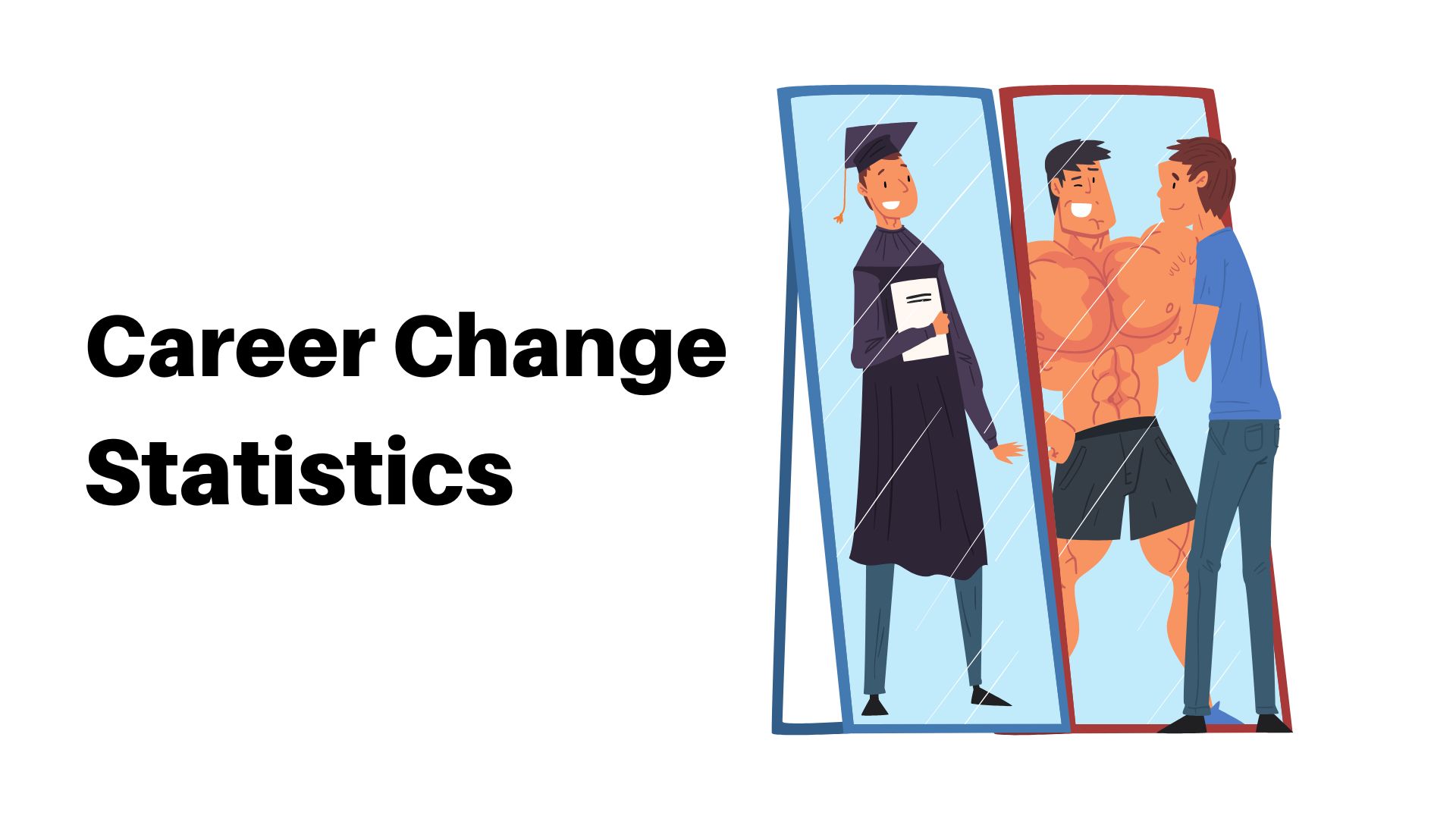
Page Contents
Introduction
Career Change Statistics: People today are considering changing careers to pursue their passions or take advantage of new opportunities in an ever-evolving employment environment. Career change statistics offer some useful insight into its frequency and consequences. Recent surveys reveal that an increasing number of professionals are considering changing careers; 39% of workers in the US alone are considering this path, according to recent surveys. Reasons for changing careers may range from dissatisfaction with current positions to a desire for better work-life balance or the pursuit of personal development and satisfaction. Switching careers can be daunting.
People must overcome hurdles such as learning new skills, adapting to an unfamiliar workplace environment, and navigating unknown sectors. Research suggests that career switches often bring positive results, with improved work-life balance, higher income potential, and increased job satisfaction among other benefits. Statistics on career changes provide invaluable guidance for anyone pondering a change as the work market evolves constantly.
- Young workers (aged 24 and younger) experience four times more job changes than workers aged 45 and above.
- An average worker typically completes approximately 100,000; hours in their lifetime.
- At least 74% of young workers; would find greater job satisfaction with jobs that provide progressive minimum wages – at least $15; an hour.
Editor’s Choice
- Compared to Black, Hispanic, and Asian employees, more white employees have been with their firm for at least 10 years.
- Individuals working in the private sector tend to switch occupations more often than those employed in public service.
- Teenager-focused employment searches have increased by 192%.
- 69% of those not working remotely have considered moving for employment purposes.
- Since there are now so many career choices, nearly one-third of the workforce changes jobs every year.
- Recent data uncovered from a national survey revealed that 52% of American workers wish to switch careers this year and 44% have already decided on change.
- These transitions are driven by various motivators such as salary increases (39%), new industry exposure (21%), or seeking upward mobility (20%).
- 39 percent of college students aged 25 or over.
- Seventy percent of workers are actively seeking new opportunities.
- Only 21% of individuals believe they are receiving fair compensation; on the other hand, 45% of workers claim they rarely or never get what they deserve.
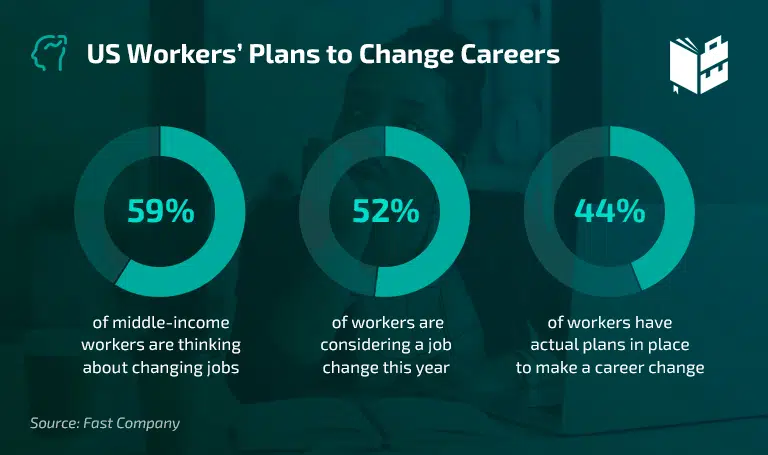
(Source: whattobecome.com)
Why Do People Change Careers?
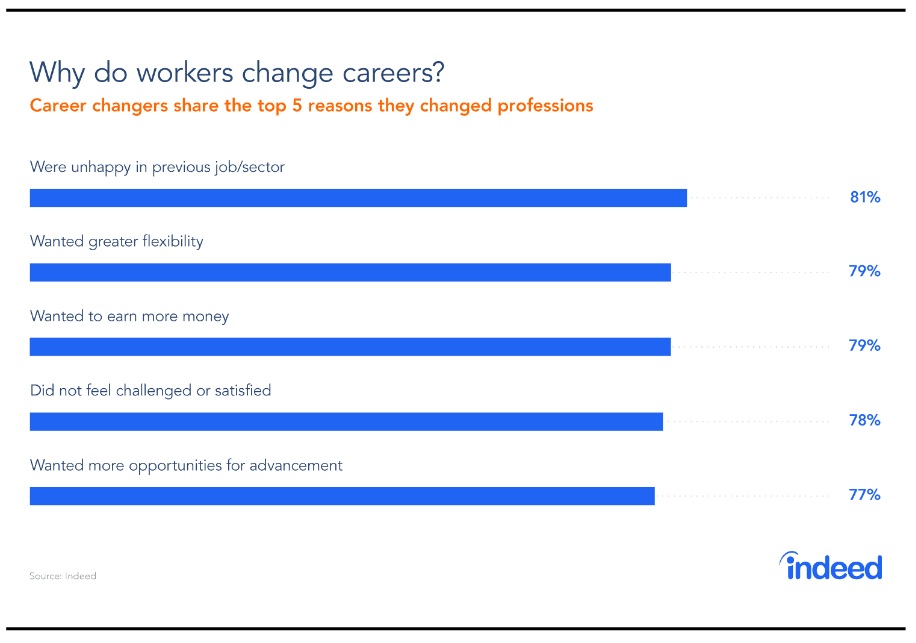
(Source: Indeed.com)
Statistics on career changes highlight the various forces affecting people's decisions to switch professions. By understanding why professionals make such changes, one may gain a better grasp of job market dynamics as well as professional requirements and aspirations changes.
- Dissatisfaction with Current Employment: Being dissatisfied with current employment can be an essential motivation for a career change. Due to factors like limited prospects for advancement or lack of fulfillment in their work environment or an imbalanced work-life balance, people may seek new professional paths more in line with their beliefs and aspirations.
- Pursuit of Passion and Interests: Many individuals change jobs in order to pursue their passions and interests more fully. Unhappy with their current career, they seek employment that better reflects their beliefs while giving them room to pursue the ones that truly excite them.
- Greater Earning Potential: Deciding to switch careers can often be driven by an ambition for greater earning potential. Professionals might opt to change fields to increase financial rewards or advance in their careers by finding sectors or jobs which provide these advantages.
- Rapid technological improvements, changing customer preferences, and shifts to the global economy may render certain businesses less viable or attractive than before. To adapt to these changes and remain relevant in developing or emerging areas, people may decide to change jobs altogether.
- Bettering one's work-life balance can be an incentive for job changes. People could look for occupations that provide more family time or provide less stress, or allow them to participate in extracurricular activities.
- Personal Development and Growth: Professionals often look for new challenges to help them evolve personally. If they feel stuck in their current positions, switching careers might open up new learning opportunities, help advance skills further, and open up wider perspectives.
- Job insecurity is a driving factor behind people seeking alternative career pathways when economic downturns, industry turbulence, or corporate restructuring occur. To increase employability and lower their chances of unemployment, people may decide to switch up their profession in order to improve employability and decrease unemployment risk.
Statistics on career transition demonstrate the similarities among various populations; studies indicate that young generations, millennials in particular, tend to change occupations more frequently than their predecessors due to a desire for purpose-driven work, flexibility, and ongoing improvement.
At the same time, however, professional changes often present challenges as well as opportunities. People may need to acquire new skills or adjust to unfamiliar working environments when transitioning between jobs. Research indicates that career switches often reap positive outcomes like improved work-life balance, higher income potential, and greater job satisfaction.
Career change data assists individuals, companies, and policymakers alike in understanding the causes, patterns, and effects of career transitions as the labor market evolves. By remaining informed of these numbers people may make better judgments when matching objectives with market demands or actively managing their professional trajectories.
General Career Change Statistics
Career change statistics provide an effective tool to understand the frequency and dynamics of professionals switching careers.
- Studies indicate that as people progress in their working lives, they become more open to changing occupations. According to a LinkedIn poll, professionals now switch professions four or five times on average during their career years.
- Major factors influencing career choices may include dissatisfaction with current job responsibilities and seeking greater fulfillment in work life. According to a University of Phoenix poll, 59% of working individuals in the United States reported they would consider changing careers if their current one is unfulfilling.
- Researchers have shown that professionals of all age groups often change careers, though those between 25-44 are particularly likely to change jobs frequently and pursue different career opportunities.
- Average employment change among 18 to 24-year-olds over six years for these individuals stands at 5.7 times.
- College graduates only utilize 21% of their full degree in the workplace.
- Only 21% of employees believe their wages are fair; according to career changer data.
- An individual will likely have held at least ten jobs by 42 years old.
- Technology advances have had an extraordinary effect on career transition trends. Professionals frequently need to switch careers or acquire new ones when sectors undergo digital disruptions; according to estimates from the World Economic Forum, automation could eliminate over 85 million jobs by 2025 alone, increasing demand for career shifts.
- Career transition often necessitates the acquisition of new abilities and knowledge. Many individuals opt for further education or training programs in order to bolster their credentials and increase their chances of success in new fields of employment, according to National Center for Education Statistics estimates. Around 8 percent of undergraduates in the US enroll in programs related to second and subsequent career options according to these statistics.
- Employing self-employment or entrepreneurial endeavors as part of career transitioning can be rewarding and fulfilling. According to the Global Entrepreneurship Monitor, 14% of American adults engaged in early-stage entrepreneurial activity – evidence that many are making decisions to establish their own companies or work for themselves.
- Research indicates that career transitions typically result in positive outcomes. According to a poll by the American Institute for Economic Research, 82% of participants who changed occupations reported being pleased or extremely pleased with their new jobs. A University of Queensland research project also demonstrated how those who pursued a change experienced greater work satisfaction as well as higher psychological well-being levels than their counterparts who did not change.
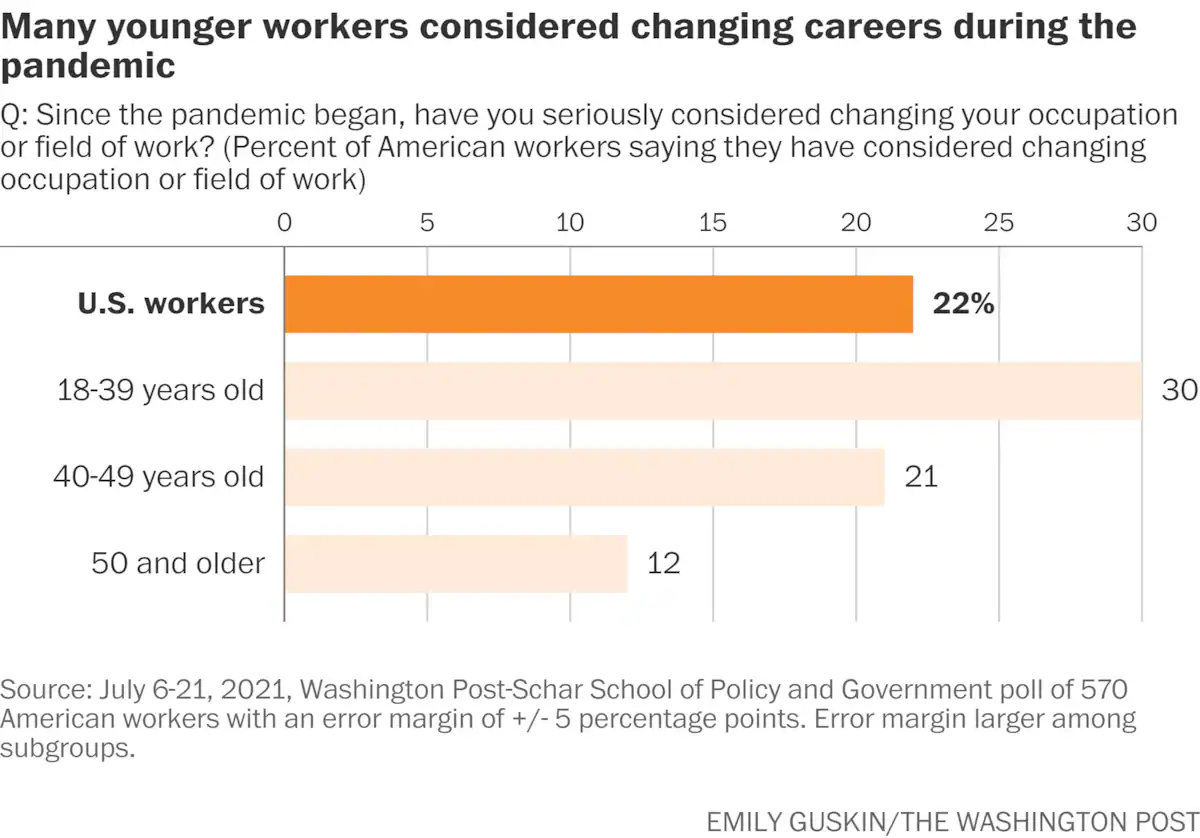
(Source: washingtonpost.com)
Career Change Statistics by Demographic
AGE
- Attracting new jobs is most likely among professionals in their 20s and 30s, with 49% reporting at least one job change within these age ranges.
- Experience, new challenges, and aligning work with personal passions and interests all contribute to job selection in their 20s and 30s age range.
- Around 33% of professionals aged 40 years or more regularly change occupations, an impressive rate that remains high despite recent decreases.
- Midlife reflection, the pursuit of greater professional fulfillment, or adapting to evolving industry dynamics are all possible motivations for changing careers in your forties.
- As people get older; their differences decrease. All of those listed are between 25 and 34 and work 4.3-4.6 jobs between their 25th and 34th birthdays; between their 35th to 44th birthdays; they take on two or three additional positions
- Professionals aged 50 or beyond also consider changing careers, though less frequently than those in younger age groups.
- At later stages of their professional lives, 7% of American citizens aged 55 or older shifted occupations during 2022.
- At fifty and beyond, people may switch careers in order to pursue long-held passions or adapt to external conditions like employment market shifts or corporate downsizing.
- As career transition statistics may vary depending on factors like nation, sector, or socioeconomic considerations, it is essential that they take these into account.
- Informal job changes such as self-employment or gig labor don't show up in formal statistics on a career change, yet have become more prevalent over time.
- Planning, gathering new knowledge or training, and expanding your professional network are essential components for making successful job changes no matter your age.
Many individuals seek help from career coaches or mentors in order to successfully navigate their process and increase their chances of success.
No matter your age, changing careers can bring many advantages: personal development, improved job satisfaction, and an alignment between work and hobbies, and passions.
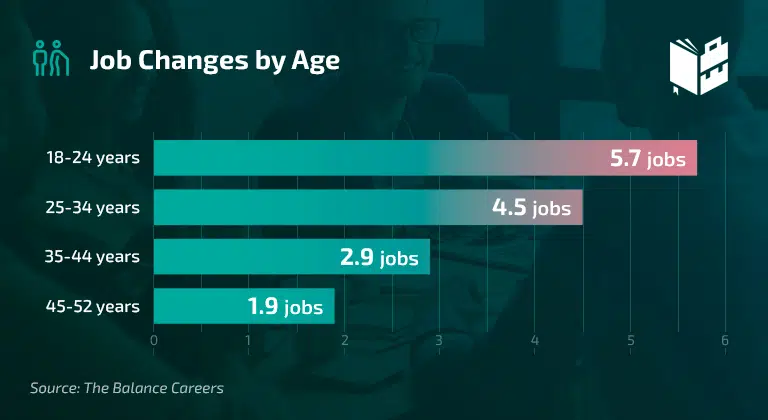
(Source: whattobecome.com)
GENDER
Statistics on professional changes by gender provide insight into trends and patterns associated with individuals pursuing new occupations. Gaining an understanding of gender dynamics may prove to be immensely helpful when factoring in personal objectives, hobbies, or market conditions that might contribute to job transitions.
- Studies indicate that women initiate career transitions more frequently than males. LinkedIn conducted a survey in 2022 that discovered that female respondents were 20% more likely than their male counterparts to switch sectors.
- Women frequently cite reasons for changing careers as wanting a better work-life balance, pursuing their passion, or fleeing an unpleasant workplace as motivations for switching positions. Men, on the other hand, might be more motivated by opportunities for career progression or financial advancement.
- Women represent 28% of total employment numbers while men account for 31%
- Statistics on career changes reveal gender disparity within industries as women often enter traditionally male-dominated fields such as technology, finance, entrepreneurship, or healthcare while men may switch into professions such as healthcare delivery or the arts.
- Life events like becoming a mother can have a significant effect on women's career transition statistics. To improve work-life balance and meet family obligations, many women prefer changing jobs or exploring flexible employment opportunities in order to meet family commitments more easily.
- Women looking to break through glass ceilings and gender inequality within their existing industries could be the driving force for career moves. Women may have less opportunity for advancement or growth within these roles than they would like, which prompts them to explore other work options.
- Statistics on career changes reveal gender disparities in self-employment and entrepreneurship, where more women than ever before are seeking independence through starting their own companies, often driven by an urge for greater freedom or simply passions they wish to explore further.
- Women remain underrepresented in fields like technology and engineering. Therefore, those seeking a change could consider professions with more diversity and opportunities for advancement.
- Women experiencing professional transition may face particular difficulties related to work-life balance, gender bias, and networking opportunities. Targeted assistance and resources must be utilized in order to overcome such hurdles.
- Women looking for successful job moves often turn to professional networks, mentors, and career development programs for assistance in making successful job transitions. Accessing such networks is essential to managing this transition process successfully.
- Men and women seeking job transitions may benefit from learning new skills or enrolling in higher education to increase their odds of success in a new industry. Lifelong learning plays a significant role in successful transitions.
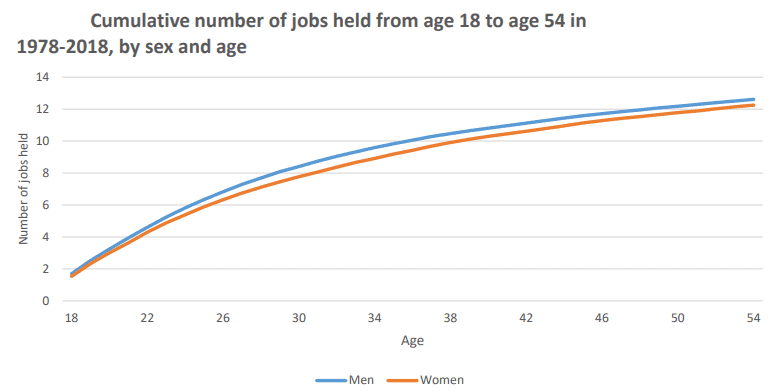
(Source: elitecontentmarketer.com)
RACE
- Research suggests that various racial groups may experience different rates of career transition; however, comprehensive and recent statistical data specifically covering career trends by race is lacking.
- Career shift trends may be affected by racial variations in socioeconomic variables like access to education, employment prospects, and professional networks. People from underrepresented ethnic backgrounds may encounter more obstacles and limited chances for professional advancement which could influence their propensity for job changes.
- Ninety-one percent of millennials; intend to change jobs every three years
- Career change trends may be affected by inequities in industry representation based on race. Due to prejudice or limited opportunities, people from historically marginalized ethnic origins may become concentrated in specific industries and encounter difficulty when trying to switch careers.
- According to research, certain ethnic backgrounds (Asian Americans and African Americans, for instance) exhibit higher rates of self-employment and entrepreneurialism than people as a whole. To create opportunities and overcome traditional employment obstacles, such groups might consider founding their own enterprises or seeking freelancing work as a way of changing careers.
- Access to resources such as financial capital, educational options, and professional networks is often necessary to successfully make career shifts. People from marginalized racial backgrounds may find it more challenging to successfully make such changes due to disparate access between races to these services.
- Career transition decisions may be affected by discrimination and bias in hiring practices and work settings, particularly racial discrimination and bias encountered during hiring procedures and work settings. When faced with discrimination or denied the chance to advance within their current careers, those affected are more likely to look elsewhere for better opportunities or more welcoming workplace environments.
EDUCATION
- Higher education levels–like bachelor's or advanced degrees–tend to be linked with greater career transition rates than lower ones. People with such degrees tend to possess a larger skill set and be better able to adapt quickly to changing career opportunities.
- As part of their transition, people may opt to pursue additional education or training to help ease the transition into their desired sector, according to data on career changes. Acquiring skills necessary for their new jobs might include earning certificates, enrolling in vocational programs, or attending specialization courses.
- 29% of graduates; have switched careers; since starting their initial postgraduate employment position.
- Half of all Americans believe that higher education; can interfere with career success or change jobs.
- Industry demands and certification requirements can have a dramatic effect on career shift trends. When employment opportunities present themselves or market demand shifts occur, individuals may seek education or training as an avenue of advancement.
- Some individuals decide to return to school to increase their employability and open doors to new job opportunities, particularly those who have been out of the workforce or with limited professional prospects.
- Non-traditional educational options like online courses, boot camps, or vocational training have become increasingly popular for people looking to change occupations. These flexible yet focused options provide individuals with the knowledge and certifications necessary to switch careers successfully.
- Career transitions can be made easier through skill-based education such as vocational or technical training programs, which focus on helping students acquire specific expertise needed in high-demand fields and increase employability.
- Less-educated individuals may face additional difficulties in transitioning between professions. Access to educational opportunities and resources could hamper their transition, thus hampering their ability to acquire new skills or credentials.
- Statistics on career transitions emphasize the significance of lifelong learning for achieving successful transitions. No matter their level of schooling, people who embrace lifelong learning and skill enhancement tend to adapt more readily to shifting job requirements and capitalize on new opportunities.
Reasons and Benefits of Career Change Statistics
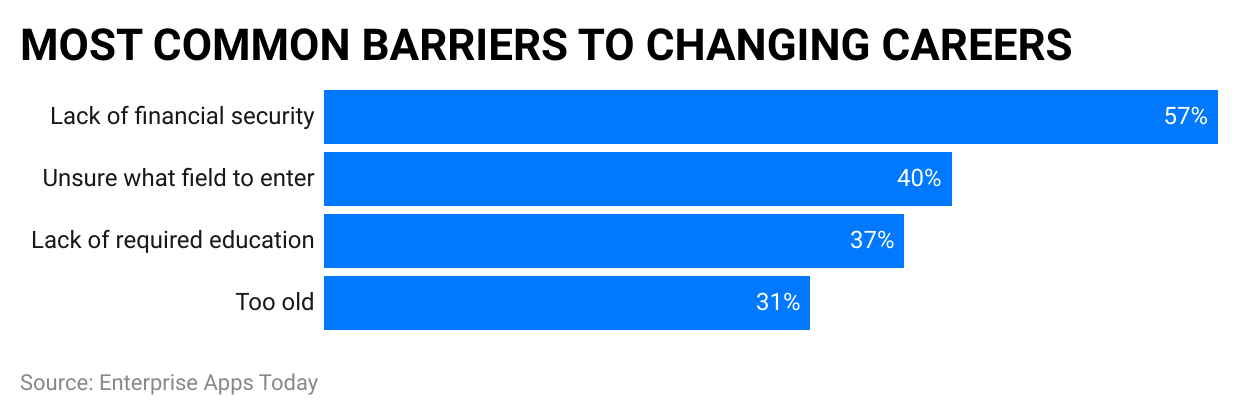
(Reference: zippia.com)
Statistics on career changes shed valuable insight into the motivations and advantages that lead people to change jobs, providing individuals and businesses with valuable data that helps shape strategies designed to promote career growth for staff members.
- Many individuals seek professional shifts as a means of personal development, according to a LinkedIn poll that revealed 58% of workers had switched occupations to pursue an interest or passion. Beginning a new career can open up exciting challenges, educational opportunities, and the possibility for the development of new skills.
- Career transitions often arise out of dissatisfaction with one's current employer or sector of the economy. According to Gallup research, only 13% of workers worldwide consider themselves engaged and satisfied in their employment – one way to increase job happiness, better align work with values, and explore occupations that offer fulfillment and purpose is by changing careers.
- Work-life balance is another significant motivation for career shifts, with 59% of FlexJobs poll respondents listing work-life balance as their top motivation.
- Financial factors should also play a part in decisions to change careers. Seeking greater financial prospects may be one reason, but not the only one; people could seek more lucrative professions or jobs with greater advancement opportunities – according to a CareerBuilder poll, 58% of workers changed occupations so as to make more money.
- Statistics on career changes can be affected by shifting business trends and labor market conditions, including technological innovations, economic shifts, or the creation of new industries. Responding to market dynamics may help individuals adapt to shifting needs while seizing opportunities presented by market dynamics.
- Utilizing transferrable talents and expertise when switching careers is common practice. People bring their prior experiences, knowledge, and abilities with them into new jobs to increase their worth and flexibility – according to LinkedIn surveys, professionals with varied skill sets were more likely to receive job offers.
- Career changes may have significant benefits on an individual's health and well-being, according to research in the Journal of Vocational Behavior. People who successfully switched to more fulfilling occupations reported higher psychological well-being and work satisfaction scores which enhanced both mental and physical well-being.
- As people change careers, new work opportunities that were once out of reach may open up to them. People can take advantage of expanding markets or in-demand professions by switching industries or upskilling. Doing this increases employability and increases their chance of finding satisfying employment.
- Networking is often key when moving careers forward. Making contacts in a new profession or business could open doors to career leads, mentoring opportunities, and useful resources – according to research conducted by Society for Human Resource Management (SHRM), networking is integral for smooth job transitions.
- Career transitions should bring personal satisfaction and pleasure. Finding work aligned with one's interests, values and passions can increase a sense of meaning in life; studies have identified an association between overall well-being and occupational happiness.
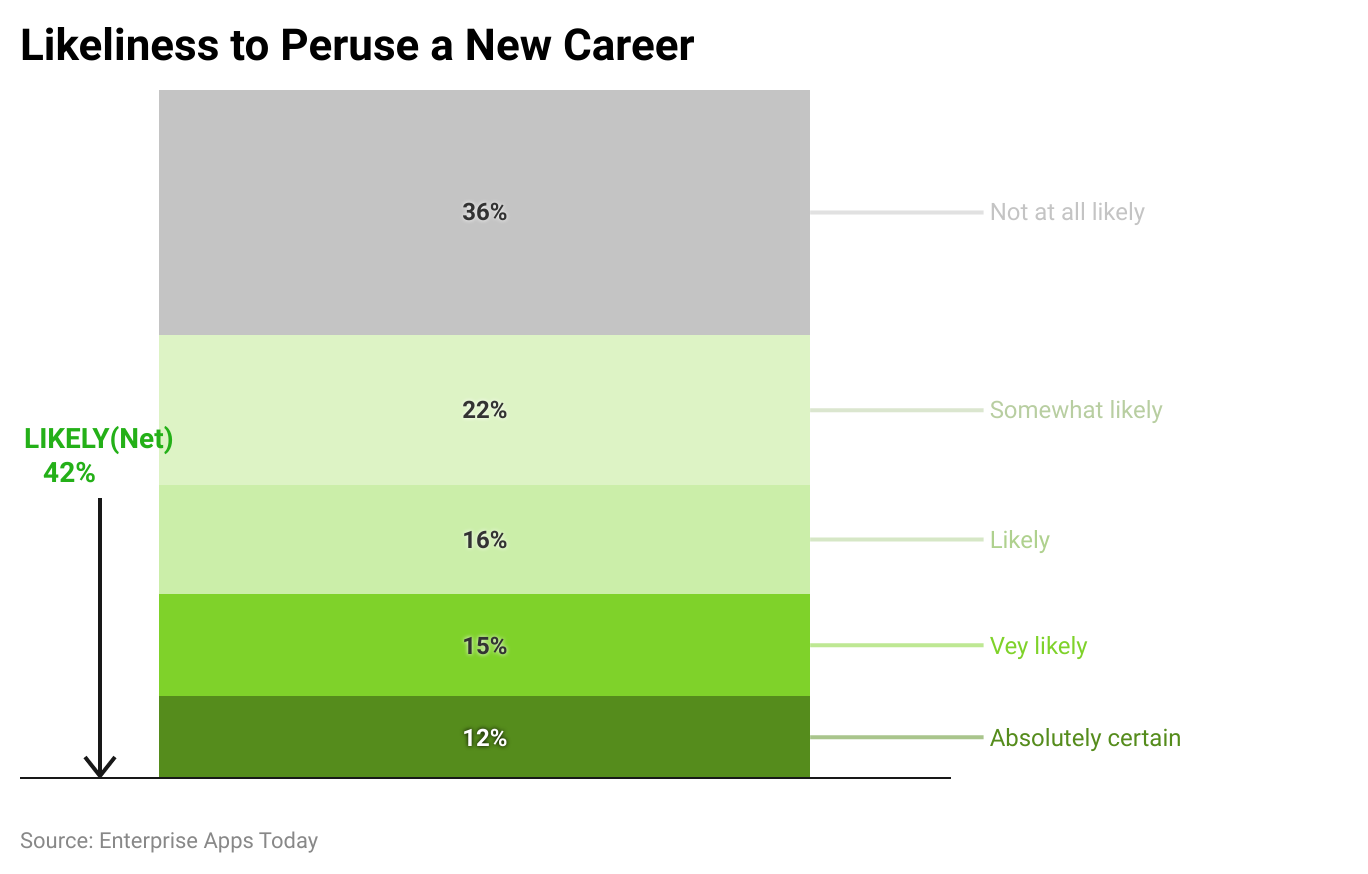
(Reference: elitecontentmarketer.com)
How Long Do People Hold On to One Job Statistics
The length of time people stay in a job can depend on a range of variables, such as industry, type of employment, personal preferences, and market conditions. Though no exact timetable exists for staying put in employment positions, data can shed light on trends and the typical length of employment terms.
- As of January 2022, according to the Bureau of Labor Statistics (BLS), the median tenure of pay and salary workers in the US averaged 4.1 years – meaning people stay with one company on average for four years before moving to another one.
- BLS statistics reveal that job tenure typically increases with age. Persons aged 55-64 had the longest median employment tenure (10.3 years), whereas younger professionals between 25-34 typically experienced greater job turnover rates due to career exploration, experience acquisition, and the pursuit of better opportunities.
- Statistics on job changes indicate that Caucasians change employment more frequently than any other race or ethnic group.
- Between 18-24, Caucasians held an average of 5.9 occupations; 30% worked at one company for more than 10 years.
- Under 45-year-old employees typically held two jobs on average. When looking at those aged 34-44 alone; this average decreases to 1.95 jobs on average.
- The duration of employment varies widely across industries and occupations. According to BLS statistics, employees in leisure and hospitality industries had an average median employment term of only 2.3 years while management, professional, and related occupations typically saw job tenures of 6.7 years on average. Seasonal or intermittent work patterns often lead to shorter job tenures.
- Generational differences vary considerably in terms of employment length. Millennials and Generation Z tend to hold jobs for shorter durations than prior generations, often switching jobs four times during their first decade after college according to LinkedIn research.
- How long people stay at their jobs depends on a number of factors, including employment security, compensation, work-life balance, wage potential, and company culture. People may remain longer in a job that suits their long-term objectives or is particularly satisfying and compatible.
- Shorter employment tenures are the result of non-traditional labor arrangements and the surge of gig economy workers. Freelancers, independent contractors, and gig workers who frequently take on various customers or projects often experience employment transitions between clients or projects.
- Market circumstances and economic cycles can have an effect on job tenure. When economic uncertainty or recession hits, people tend to prefer stability over change. On the other hand, during periods of expansion, people could look for greater possibilities by shifting jobs more frequently.
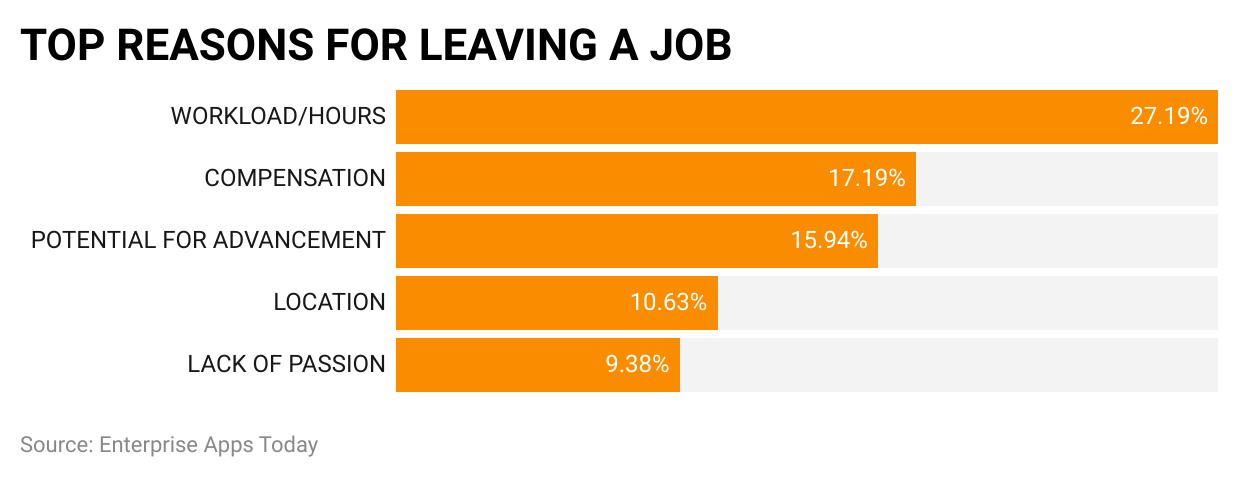
(Reference: online.drexel.edu)
Career Change Trends and Projections
Career transition trends and forecasts offer valuable insights into changing employment market dynamics and people's evolving career goals. Predicting future patterns helps us adapt quickly to any alterations that occur within an ever-evolving environment.
- As career paths shift and technological improvements arise; more people are opting for job flexibility by switching fields throughout their lifetimes. Technological advances, shifting employment market needs, and personal aspirations all play into this trend.
- Since the COVID-19 pandemic began; remote and flexible work arrangements have become more prevalent. People now have greater freedom when considering career decisions without being limited by geography; and it is expected that remote employment will only continue growing – offering people new opportunities without forcing them to relocate.
- As technology rapidly develops, the job market is shifting; certain skills are becoming obsolete while others become increasingly valued. Transferable talents such as adaptability, critical thinking, communication, and digital literacy are highly prized today and individuals with these traits can move easily between occupations and sectors.
- Maintaining professional shifts requires lifelong learning and skill enhancement. As automation and artificial intelligence become more impactful in various businesses, more retraining and upskilling may become necessary to transfer to growing professions and remain competitive. People must pick up new skills in order to remain employable.
- Entrepreneurship and the gig economy are expected to experience exponential growth. More people are turning to self-employment, freelancing, or starting their own enterprises in search of more autonomy, flexibility, and opportunities to follow their passions. By choosing this path of self-determination they may take charge of their professional future by designing their own career trajectories and taking charge of their professional futures.
- Young workers especially value having meaning and purpose in their job. With more people choosing jobs that align with their beliefs, environmental sustainability, social impact, and personal fulfillment as their top priorities; this trend should only continue. More individuals may change careers seeking purpose.
- Technology employment opportunities are projected to surge quickly over the coming decade. Individuals skilled in artificial intelligence, data analysis, cybersecurity, and software development should find new career paths opening up rapidly as automation and digitalization disrupt businesses.
- Due to longer life expectancies and the need to remain actively involved, older individuals may opt for job shifts or phased retirement as a solution. They could look for fresh challenges through second jobs or leverage their experience by taking on consulting or mentoring roles.
- The COVID-19 epidemic has highlighted the significance of total well-being, mental health, and work-life balance as values to strive towards. People now place a higher value on occupations that support overall well-being and seek work settings that promote both professional and personal development.
- Education and training have never been more widely accessible thanks to online and remote learning systems. With access from any device anywhere to acquire new skills and certifications from home, this accessibility should inevitably drive job shift patterns forward.
Final Words
Statistics on career changes provide crucial insight into their mechanics. They demonstrate how often job transitions occur in various sectors, educational levels, and demographics; their figures also illuminate why professional transitions take place and can be spurred by personal development, work dissatisfaction, market developments, or financial concerns. Finally, statistics reveal just how vital lifelong learning and skill development are in facilitating smooth job transitions; people must adapt quickly to shifting work market requirements while picking up new abilities that allow for new possibilities to come their way.
Statistics on job changes demonstrate how the nature of work is evolving and career paths becoming more flexible, with people opening themselves up to entrepreneurial endeavors, and new markets, prioritizing work-life balance and personal fulfillment, prioritizing work-life balance and personal fulfillment in their employment choices, and choosing different paths altogether. Career change data serves as a reminder that people can choose their own professional paths – professions do not remain static – making awareness of this fact key for both individuals and businesses designing plans to encourage the professional growth and satisfaction of their workforces
FAQ.
No matter how you approach it, be honest and straightforward when discussing it with your manager. Even though you like your current role, if there are more duties you would like to add let them know right away that joining this team, working with this individual, or participating in this project might help you do so.
People frequently change jobs to gain experience in certain fields or businesses. By switching careers, individuals may acquire the necessary expertise that will lead to their professional growth and development.
Switching careers could bring new opportunities, higher pay and greater fulfilment if your work environment makes you unhappy, irritable or disinterested; perhaps now is the time for change as continuing in an occupation you don't enjoy is bad for both physical and psychological well-being.
Your work provides you with a sense of purpose; daily goals to strive towards and a source of revenue to support daily needs. Even if you switch occupations later in life, working can give you access to skills necessary for future roles.

Barry is a lover of everything technology. Figuring out how the software works and creating content to shed more light on the value it offers users is his favorite pastime. When not evaluating apps or programs, he's busy trying out new healthy recipes, doing yoga, meditating, or taking nature walks with his little one.